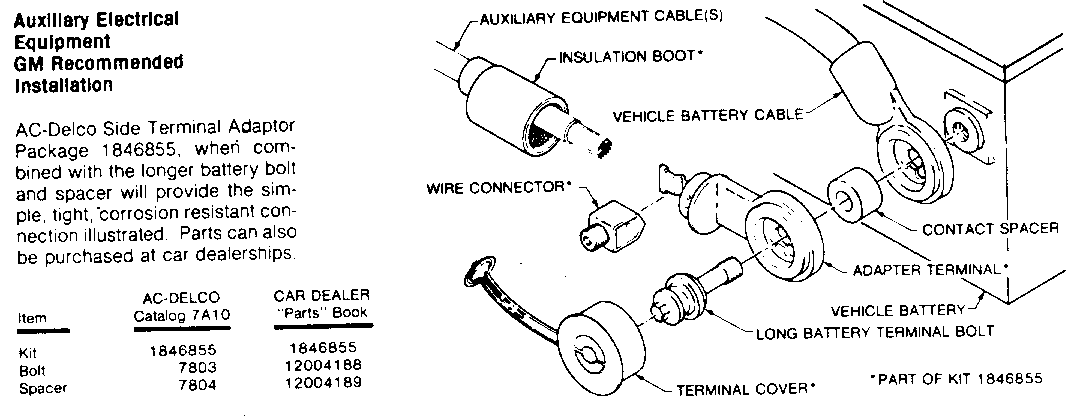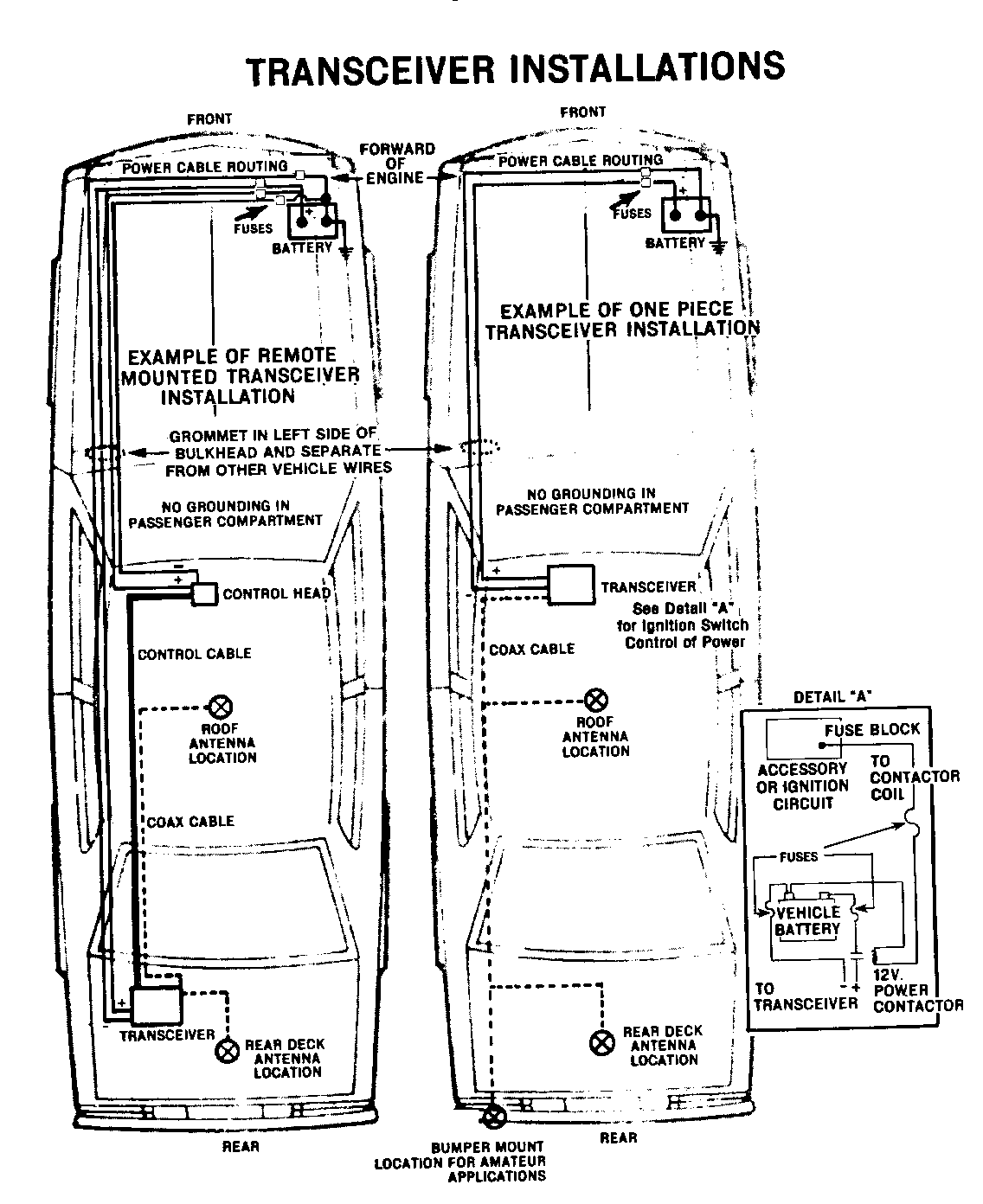INSTALLATION GUIDELINES FOR AFTERMARKET ACCESSORIES

All 1989 and 1990 Cadillac Owner's Manuals contain the following notices:
Under "Sound Systems":
NOTICE: Before you add any sound equipment to your vehicle -- like a tape player, CB radio, mobile telephone, or two-way radio -- be sure you can add what you want. If you can, it's very important to do it properly. Added sound equipment may interfere with the operation of your car's engine, Delco radio, or other systems and even damage them. And, your car's system may interfere with the operation of sound equipment that has been added improperly.
So before adding sound equipment, check with your dealer. For radio telephones and mobile radios, you can get our "Radio Telephone/Mobile Radio Installation Guidelines". Write to:
EMC Department--MR Building 40 GM Proving Grounds Milford, MI 48042
Mobile radio and telephone units are covered by federal rules and must be installed by trained people.
Under "Add On Electrical Equipment":
NOTICE: Don't add anything electrical to your Cadillac unless you check with your dealer first. Some electrical equipment can damage your vehicle and the damage wouldn't be covered by your warranty. Some of it can just keep other things from working as they should.
The notice in the "Sound Systems" Section references information available from the EMC Department at the GM Milford Proving Grounds. Attachment A is a reprint of the guidelines which your dealership can use for customers or after-market installers who request information. (Copies of the information will continue to be available through the EMC Department.)
The following information provides more specific guidelines for applying after-market equipment:
The popularity and variety of electronic after-market auto accessories is rapidly growing. Many of these devices require permanent connections to the electrical system of the vehicle. These installations are usually performed by the dealership, a specialty shop, or the customer.
Today's automotive electrical systems are very sophisticated. Improperly installed electrical accessories can interfere with the vehicle's operation, performance, and in some circumstances, cause damage to the vehicle which would not be covered under the General Motors New Vehicle Warranty. Possible problems to the vehicle include but are not limited to: stalling, surging, poor performance, detonation, blown fuses, damaged wiring, cluster lighting changes, battery drains, alarm system failures, premature relay failures, poor radio reception, radio speaker noises, and unsafe driving conditions.
Many customers who encounter after-market accessory related problems may in error fault the original manufacturer of the vehicle as the cause of the problem. Therefore, in the interest of customer satisfaction technicians should check for add-on (non-OEM) electrical equipment as the first step in diagnosing electrical problems. If the vehicle is so equipped, disconnect the system to verify that these add-on "accessories" are not the cause of the resulting noise interference.
Installation guidelines are listed below. These guidelines are intended to supplement, but not replace, the instructions supplied by the manufacturer. Instructions for add-on installations are the sole responsibility of the manufacturer of the radio, telephone, land mobile radio, or other accessory.
NOTE: Due to the variety of the after-market accessories, consult the manufacturer for additional details specific to their product.
In general there are three classes of after-market equipment.
1. Devices that only require power and ground connections.
Never tie directly into the vehicle's wiring system. Use only direct power and ground feeds from the battery or the junction block.
To eliminate voltage spikes do not tie into existing ground connections. Accessories that use low current can be grounded at the left door hinge pillar.
Install an in-line fuse holder on the power wire as close to the battery as possible. Only use fuses of the correct amperage as specified by the manufacturer of the add-on device.
Twist the lengths of the power and ground wires together as much as possible to reduce magnetic interference.
Route wires away from all existing harnesses. Pay particular attention to all ECM, ignition, and radio wiring.
If the device must be ignition operated, use the auxiliary ignition jack in the fuse box and install an in-line fuse. In some cases you may have to add a suppression filter. (Refer to Delco Service Managers - Sound Guide.)
2. Devices that require connections to vehicle systems or components.
Follow the above procedures for the power and ground connections.
When the manufacturer's directions require the device be tapped into vehicle systems, such as speed sensor, door lock wiring, courtesy light circuits, etc., it is important to verify that the addition does not affect the intended function of the circuit or its related components (i.e., reduce signal strength; create a current draw through switches, relays, and connectors exceeding their ratings, or generate electromagnetic interference).
All wiring must be of equal gage size to the source circuit. This will help ensure adequate failure mode protection.
Splices, taps, and other wiring alterations should be soldered and insulated with heat shrink tubing to prevent corrosion and resistance build up. Do not use quick-lock type splices.
3. Devices that transmit a radio signal or magnetic waves.
These include mobile telephones, two-way business radios, C.B. radios, and ham radios. See Attachment A which is also available from the GM Proving Grounds EMC Department.


General Motors bulletins are intended for use by professional technicians, not a "do-it-yourselfer". They are written to inform those technicians of conditions that may occur on some vehicles, or to provide information that could assist in the proper service of a vehicle. Properly trained technicians have the equipment, tools, safety instructions and know-how to do a job properly and safely. If a condition is described, do not assume that the bulletin applies to your vehicle, or that your vehicle will have that condition. See a General Motors dealer servicing your brand of General Motors vehicle for information on whether your vehicle may benefit from the information.
